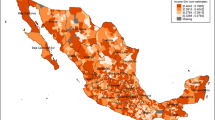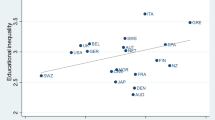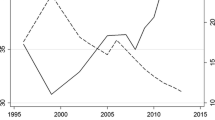Abstract
This paper tests the causal processes between income and educational inequality within regions of the European Union, using a spatial cross-regressive VAR framework. The results show that there is a heterogeneous causality from income inequality to educational inequality and vice versa, and interregional income and educational externalities are relevant to this causality. This finding raises potentially interesting economic policy implications.
Similar content being viewed by others
Notes
A researcher taking the structural approach, through the use of theory, can obtain restrictions to help pin down parameters and, by estimating the structural parameters of a fully specified model, can simulate the impact of alternatives that have never actually occurred in the data (Holmes 2010). However, a cost of the structural approach is that the researcher must be explicit up-front about the underlying model and the underlying economics. This paper puts emphasis on the importance of interregional externalities which occur through many mechanisms. Therefore, adopting a data-driven model, I do not need to make explicit up-front the underlying mechanisms of interregional externalities. Structural econometric modellers must also add statistical structure in order to rationalise why economic theory does not perfectly explain data and must be able to argue that their model will be invariant to the contemplated change in economic environment (Reiss and Wolak 2007). A data-driven model does not face this problem, because a structural model is not based on an artificial economy. Moreover, I do not use a structural model because causal relations cannot be established a priori (Hume 1748). In the proposed model, I construct a spatial weights matrix (see Sect. 2) which captures externalities. Instead of constructing the spatial weights matrix, some researchers suggest directly entering variables that proxy externalities in the regression model (see Harris et al. 2011). Nevertheless, Corrado and Fingleton (2012) argue that such an approach itself requires strong identifying assumptions and therefore possesses no real advantage compared to employing a spatial weights matrix. Modelling spatial interaction in the economic context means in many cases modelling externalities which are difficult to pin down (Corrado and Fingleton 2012). Overall, the putative advantages do not always mean structural models should be favoured over non-structural models. Reiss and Wolak (2007) say that ‘[t]he advantages of structural models of course do not all come for free. All economic theories contain assumptions that are not easily relaxed. While theorists sometimes have the luxury of being able to explore stylized models with simplifying assumptions, structural econometric modelers have to worry that when they use stylized or simplifying assumptions they will be dismissed as arbitrary, or worse: insensitive top the way the world ‘real works” (page 4290).
Granger-causality is a statistical concept of causality that is based on prediction and its mathematical formulation is based on linear regression modelling of stochastic processes (Granger 1969).
For a review of the ECHP survey see Peracchi (2002).
The successor to the ECHP came in the form of the EU Statistics on Income and Living Conditions (EU-SILC) which was launched in 2003 (Atkinson and Marlier 2010). The EU-SILC differs markedly from its predecessor in two important ways: (a) while the ECHP has the advantage of being input-harmonised, that is of being based on standardised questionnaires common across all of the countries where it was implemented, the EU-SILC is output-harmonised, that is, instead of being based on harmonised questionnaires, the procedure involves the specification of a set of social and economic indicators which should be provided by the new data set, but it is up to each member state to decide how these are to be collected; (b) whereas the ECHP is a panel survey, in which the same individuals were interviewed year after year, the EU-SILC takes the form of a rotating panel, where the individuals are interviewed usually for a maximum of four years, and the sample is regularly refreshed with new members (Iacovou et al. 2012). According to Longford et al. (2010), the EU-SILC ‘provides reliable statistics at national level but sample sizes do not allow reliable estimates at subnational level, despite a rising demand from policy-makers and local authorities’ (page 1). Finally, although the EU-SILC survey domains over the enlarged EU, micro-data that would enable us to identify regions and compare them are available only for a few countries (Longford et al. 2010). For example, no location is indicated in the data for the UK, and it is collapsed to only six categories in Germany (Longford et al. 2010).
Nomenclature of Territorial Units for Statistics (NUTS) provides a single uniform breakdown of territorial units where each member state is subdivided into three administrative units (NUTS I, II and III).
The procedure proposed to measure educational inequality is better than just using the variance for two main reasons. (a) It allows us to compare educational inequality with income inequality, as they use the same disproportionality functions and thus the same indices (i.e. Theil index of income and Theil index of education, or Gini coefficient on income and Gini coefficient on education). More specifically, in the literature on inequality, it is conceptualised as the average disproportionality. Inequality concerns a ‘disproportionate share’, which means a share that is bigger or smaller than the average share of all basic units. The challenge for the inequality literature is to comprehend how to aggregate those basic unit disproportionalities to obtain a measure of overall inequality. As each region has a different distribution of income (resp. education), an index of income (resp. education) inequality that is comparable across regions has to be compiled. The index should be fundamentally based on the principle that income (resp. education) inequality increases as the income (resp. education) ratios deviate from 1.0. Hence, the task in hand is to devise summary measures of income (resp. education) inequality that distinguish more inequality from less inequality (Firebaugh 2003). Conceptualising inequality as the average disproportionality across all basic units implies that the degree of income (resp. education) inequality depends on the average distance of the income (resp. education) ratios \(r_{i}\) from 1.0. Income (resp. education) inequality is unaffected by proportional increases or decreases. Inequality indices \(I\) are expressed in a common form \(I=\frac{1}{N}\sum _{i=1}^N {f(r_{i} )} \), where \(f\) denotes the disproportionality or distance function which captures the mathematical functions for determining deviations of income (resp. education) ratios from 1.0. (b) This procedure was initially used by Thomas et al. (2001) and, more recently, by Tselios (2008) and Rodríguez-Pose and Tselios (2009a).
These results can be provided upon request.
References
Abreu M, De Groot HLF, Florax RJGM (2005) Space and growth: a survey of empirical evidence and methods. Région et Développement 21:12–43
Anselin L (1988) Spatial econometrics: methods and models. Studies in operational regional science, Kluwer, Dordrecht
Anselin L (1992) SpaceStat Tutorial: a workbook of using SpaceStat in the analysis of spatial data. University of Illinois, Urbana
Anselin L (2000) Spatial econometrics. In: Baltagi BH (ed) A companion to theoretical econometrics. Blackwell, Oxford, pp 310–330
Anselin L, Bera AK (1998) Spatial dependence in linear regression models with an introduction to spatial econometrics. In: Ullah A, Giles DEA (eds) Handbook of applied economic statistics. Marcel Dekker, New York, pp 237–289
Anselin L, Rey S (1991) Properties of tests for spatial dependence in linear regression models. Geogr Anal 23(2):112–131
Armstrong HW (2002) European Union regional policy: reconciling the convergence and evaluation evidence. In: Cuadrado-Roura JR, Parellada M (eds) Regional convergence in the European Union: facts, prospects, and policies. Springer, Berlin, New York, pp 211–230
Atkinson AB, Marlier E (eds) (2010) Income and living conditions in Europe Eurostat European Commission. Publications Office of the EU, Luxembourg
Becker GS, Chiswick BR (1966) Economics of education and distribution of earnings. Am Econ Rev 56(2):358–369
Centre for Educational Research and Innovation, Organisation for Economic Co-operation and Development (1998) Human capital investment: an international comparison. Organisation for Economic Co-operation and Development, Paris
Cliff AD, Ord JK (1981) Spatial processes: models & applications. Pion, London
Corrado L, Fingleton B (2012) Where is the economics in spatial econometrics? J Reg Sci 52(2):210–239. doi:10.1111/j.1467-9787.2011.00726.x
Erdil E, Yetkiner IH (2009) The Granger-causality between health care expenditure and output: a panel data approach. Appl Econ 41(4):511–518
Ertur C, Le Gallo J, Baumont C (2006) The European regional convergence process, 1980–1995: do spatial regimes and spatial dependence matter? Int Reg Sci Rev 29(1):3–34
Firebaugh G (2003) The new geography of global income inequality. Harvard University Press, Cambridge, MA
Florax R, Folmer H, Rey SJ (2003) Specification searches in spatial econometrics: the relevance of Hendry’s methodology. Reg Sci Urban Econ 33(5):557–579
Galor O, Moav O (2000) Ability-biased technological transition, wage inequality, and economic growth. Q J Econ 115(2):469–497
Galor O, Moav O (2004) From physical to human capital accumulation: inequality and the process of development. Rev Econ Stud 71(4):1001–1026
Galor O, Zeira J (1993) Income distribution and macroeconomics. Rev Econ Stud 60(1):35–52
Granger CWJ (1969) Investigating causal relations by econometric models and cross-spectral methods. Econometrics 37(3):424–438
Greene WH (2003) Econometric analysis, 5th edn. Prentice Hall, Upper Saddle River, NJ (Great Britain)
Gujarati DN (2003) Basic econometrics, 4th edn. McGraw-Hill, Boston
Harris R, Moffat J, Kravtsova V (2011) In search of ‘W’. Spat Econ Anal 6(3):249–270. doi:10.1080/17421772.2011.586721
Holmes TJ (2010) Structural, experimentalist, and descriptive approaches to empirical work in regional economics. J Reg Sci 50(1):5–22. doi:10.1111/j.1467-9787.2009.00637.x
Hood MV III, Kidd Q, Morris IL (2008) Two sides of the same coin? Employing Granger causality tests in a time series cross-section framework. Polit Anal 16(3):324–344
Hume D (1748) An enquiry concerning human understanding. Bobbs-Merrill, Indianapolis
Hurlin C, Venet B (2001) Granger causality tests in panel data models with fixed coefficients. Working paper Eurisco 2001-09, University of Paris Dauphine
Iacovou M, Kaminska O, Levy H (2012) Using EU-SILC data for cross-national analysis: strengths, problems and recommendations. ISER Working paper series, No. 2012-03, Institute for Social and Economic Research (ISER), Essex University
Jesuit DK, Rainwater L, Smeeding TM (2003) Regional poverty within the rich countries. In: Bishop J, Amiel Y (eds) Inequality, welfare and poverty: theory and measurement, vol 9. Elsevier Science, New York, pp 345–377
Le Gallo J, Ertur C, Baumont C (2003) A spatial econometric analysis of convergence across European regions. In: Fingleton B (ed) European regional growth. Springer, Berlin, pp 1980–1995
Longford NT, Grazia Pittau M, Zelli R, Massari R (2010) Measures of poverty and inequality in the countries and regions of EU. Working Paper Series, ECINEQ WP 2010-182, ECINE Society for the Study of Economic Inequality
Magrini S (2004) Regional (di)convergence. In: Henderson JV, Thisse JF (eds) Handbook of regional and urban economics, vol 4. Elsevier, Amsterdam, pp 2741–2796
McCann P, Shefer S (2005) Agglomeration, economic geography and regional growth. Pap Reg Sci 84(3):301–309
Moreno R, Paci R, Usai S (2005) Spatial spillovers and innovation activity in European regions. Environ Plan A 37(10):1793–1812
Peracchi F (2002) The European community household panel: a review. Empir Econ 27(1):63–90
Pfaffermayr M (2009) Conditional beta- and sigma-convergence in space: a maximum likelihood approach. Reg Sci Urban Econ 39(1):63–78
Reiss PC, Wolak FA (2007) Structural econometric modeling: rationales and examples from industrial organisation. In: Heckman JJ, Leamer EE (eds) Handbook of econometrics, vol 6A. North-Holland, Elsevier, pp 4277–4412
Rodríguez-Pose A, Crescenzi R (2008) R&D, spillovers, innovation systems and the genesis of regional growth in Europe. Reg Stud 42(1):51–67
Rodríguez-Pose A, Tselios V (2009a) Education and income inequality in the regions of the European Union. J Reg Sci 49(3):411–437. doi:10.1111/j.1467-9787.2008.00602.x
Rodríguez-Pose A, Tselios V (2009b) Mapping regional personal income distribution in Western Europe: income per capita and inequality. Financ Uver-Czech J Econ Financ 59(1):41–70
Rodríguez-Pose A, Tselios V (2010) Inequalities in income and education and regional economic growth in western Europe. Ann Reg Sci 44(2):349–375
Rodríguez-Pose A, Tselios V (2011) Mapping the European regional educational distribution. Eur Urban Reg Stud 18(4):358–374. doi:10.1177/0969776411399345
Rodríguez-Pose A, Vilalta-Bufí M (2005) Education, migration, and job satisfaction: the regional returns of human capital in the E.U. J Econ Geogr 5(5):545–566
Sianesi B, Van Reenen J (2003) The returns to education: macroeconomics. J Econ Surv 17(2):157–200
Spence AM (1973) Job market signaling. Q J Econ 87(3):355–374
Sterlacchini A (2008) R&D, higher education and regional growth: uneven linkages among European regions. Res Policy 37(6–7):1096–1107
Theil H (1967) Economics and information theory. Studies in mathematical and managerial economics, vol 7. North-Holland, Amsterdam
Thomas V, Wang Y, Fan X (2001) Measuring education inequality: Gini coefficients of education. Policy research working paper; 2525. World Bank, Washington, DC
Thorbecke E, Charumilind C (2002) Economic inequality and its socioeconomic impact. World Dev 30(9):1477–1495
Tselios V (2008) Income and educational inequalities in the regions of the European Union: geographical spillovers under welfare state restrictions. Pap Reg Sci 87(3):403–430
Tselios V (2011) Is inequality good for innovation? Int Reg Sci Rev 34(1):75–101. doi:10.1177/0160017610383278
Vayá E, López-Bazo E, Moreno R, Surinach J (2004) Growth and externalities across economies: an empirical analysis using spatial econometrics. In: Anselin L, Florax RJGM, Rey SJ (eds) Advances in spatial econometrics: methodology, tools and applications. Springer, Berlin, pp 433–455
Author information
Authors and Affiliations
Corresponding author
Rights and permissions
About this article
Cite this article
Tselios, V. The Granger-causality between income and educational inequality: a spatial cross-regressive VAR framework. Ann Reg Sci 53, 221–243 (2014). https://doi.org/10.1007/s00168-014-0626-0
Received:
Accepted:
Published:
Issue Date:
DOI: https://doi.org/10.1007/s00168-014-0626-0




